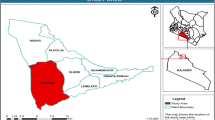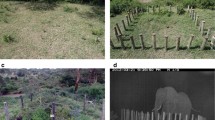Abstract
This study aimed to identify dominant plant communities across five wet and mesic meadows in the Sierra Nevada Range (California, USA) and examine the impacts of environmental and grazing gradients on plant community distribution and diversity. Species composition and environmental conditions were recorded in 100 plots over two years. Classification and ordination analyses were used to classify plant communities and identify relationships between community types and both environmental and grazing gradients. We identified the following six plant community types: Carex jonesii, Carex leporinella, Carex nebrascensis, Carex utriculata, Eleocharis pauciflora, and Veratrum californicum. We found strong connections between plant communities and water table variables, with low water table (r 2 = 0.56) and mean water table (r 2 = 0.30) significantly correlated with Axis 1 while high water table (r 2 = 0.29) and elevation were correlated with Axis 3 (r 2 = 0.49). We found significant differences among community types for all three water table variables and for elevation. We found no correlation between grazing and community type classification, but there was a significant difference in grazing levels among community types. The plant communities and relationships to water table found in this work may aid managers in understanding present conditions and identifying future changes in meadow ecosystems.


Similar content being viewed by others
References
Allen-Diaz BH (1991) Water table and plant species relationships in Sierra Nevada meadows. Am Midl Nat 126:30–43
Austin JE, Keough JR, Pyle WH (2007) Effects of habitat management treatments on plant community composition and biomass in a montane wetland. Wetlands 27:570–587
Bennett PS (1965) An investigation of the impact of grazing on 10 meadows in Sequoia and Kings Canyon National Parks. MS Thesis, San Jose State College
Bonham CD (1989) Measurements for terrestrial vegetation. John Wiley and Sons, New York
Bray JR, Curtis JT (1957) An ordination of the upland forest communities of southern Wisconsin. Ecol Monogr 27:325–349
Carle D (2004) Introduction to Water in California. University of California Press, Berkeley
Castelli RM, Chambers JC, Tausch RJ (2000) Soil–plant relations along a soil–water gradient in Great Basin riparian meadows. Wetlands 20:251–266
Chambers JC, Blank RR, Zamudio DC, Tausch RJ (1999) Central Nevada riparian areas: physical and chemical properties of meadow soils. J Range Manage 52:92–99
Daly C, Gibson WP, Taylor GH, Johnson GL, Pasteris P (2002) A knowledge-based approach to the statistical mapping of climate. Clim Res 22:99–113
Drewa PB, Platt WJ, Moser EB (2002) Community structure along elevation gradients in headwater regions of longleaf pine savannas. Plant Ecol 160:61–78
Dwire KA, Kauffman JB, Baham JE (2006) Plant species distribution in relation to water-table depth and soil redox potential in montane riparian wetlands. Wetlands 26:131–146
Friedel MH, Chewings VH, Bastin GN (1988) The use of comparative yield and dry- weight-rank techniques for monitoring arid rangeland. J Range Manage 41:430–435
Hammersmark CT, Rains MC, Wickland AC, Mount JF (2009) Vegetation and water- table relationships in a hydrologically restored riparian meadow. Wetlands 29:785–797
Haydock KP, Shaw NH (1975) Correction-the comparative yield method for estimating dry matter yield of pasture. Aust J Exp Agric 15:663–670
Hayes GF, Holl KD (2003) Cattle grazing impacts on annual forbs and vegetation in mesic grasslands in California. Conserv Biol 17:1694–1702
Heady HF (1957) Effect of cages on yield and composition in the California annual type. J Range Manage 10:175–177
Hickman JC (1993) The Jepson Manual: Higher Plants of California. University of California Press, Berkeley
Hill MO (1979) TWINSPAN-A FORTRAN Program for Arranging Multivariate Data in an Ordered Two-Way Table by Classification of Individuals and Attributes. Cornell University, Ithaca
Hurd EG, Shaw NL, Mastrogiuseppe J, Smithman LC, Goodrich S (1998) Field Guide to Intermountain Sedges. General Technical Report RMRS-GTR-10. USDA Forest Service, Ogden
Jackson RD, Allen-Diaz BH (2006) Spring-fed wetland and riparian plant communities respond differently to altered grazing intensity. J Appl Ecol 43:485–498
Kauffman JB, Krueger WC (1984) Livestock impacts on riparian ecosystems and streamside management implications…a review. J Range Manage 37:430–438
Kluse JS, Allen-Diaz BH (2005) Importance of soil moisture and its interaction with competition and clipping for two montane meadow grasses. Plant Ecol 176:87–99
Knapp RA, Matthews KR (1996) Livestock grazing, golden trout, and streams in the Golden Trout Wilderness, California: impacts and management implications. North Am J Fish Manag 16:805–820
Kruskal JB (1964) Multidimensional scaling by optimizing goodness of fit to a nonmetric hypothesis. Psychometrika 29:1–27
Loheide SP, Gorelick SM (2007) Riparian hydroecology: A coupled model of the observed interactions between groundwater flow and meadow vegetation patterning. Water Resour Res 43:1–16
Magee TK, Kentula ME (2005) Response of wetland plant species to hydrologic conditions. Wetl Ecol Manage 13:163–181
Martin DW, Chambers JC (2001) Effects of water table, clipping, and species interactions on Carex nebrascensis and Poa pratensis in riparian meadows. Wetlands 21:422–430
McCune B, Grace JB (2002) Analysis of ecological communities. MjM Software Design, Gleneden Beach
McCune B, Mefford MJ (1999) PC-ORD. Multivariate analysis of ecological data, Version 4.0. MjM Software Design, Gleneden Beach
McIlroy SK, Allen-Diaz BH, Berg AC (2011) Using digital photography to examine grazing in montane meadows. Rangel Ecol Manag 64:187–195
Menke JW, Davis C, Beesley P (1996) Rangeland assessment. In: Sierra Nevada Ecosystem Project, final report to Congress. Vol. III, Assessments and scientific basis for management options
Mitsch WJ, Gosselink JG (1993) Wetlands, 2nd edn. Van Nostrand Reinhold, New York
Moore JG (2000) Exploring the highest sierra. Stanford University Press, Stanford, Ca, USA
Moran J, Sheehy Skeffington M, Gormally M (2008) The influence of hydrological regime and grazing management on the plant communities of a karst wetland (Skealoghan turlough) in Ireland. Appl Veg Sci 11:13–24
Poulos HM, Taylor AH, Beaty RM (2007) Environmental controls on dominance and diversity of woody plant species in a Madrean, Sky Island ecosystem, Arizona, USA. Plant Ecol 193:15–30
Ratliff RD (1985) Meadows in the Sierra Nevada of California: state of knowledge. Gen. Tech. Rep. PSW-GTR-84. USDA Forest Service, Berkeley
Robins JD, Vollmar JE (2002) Livestock grazing and vernal pools. In: Vollmer JE (ed) Wildlife and rare plant ecology of eastern Merced County’s vernal pool grasslands. Vollmar Consulting, Berkeley, pp 401–430
Sala A, Nowak RS (1997) Ecophysiological responses of three riparian graminoids to changes in the soil water table. Int J Plant Sci 158:835–845
Statacorp (2009) STATA statistical software: release 11.0. Statacorp, College Station
Stoddart LA, Smith AD, Box TW (1975) Range Management, 3rd edn. McGraw-Hill, New York
USDA Forest Service (2001) Sierra Nevada Forest Plan Amendment: final environmental impact statement and record of decision. USDA Forest Service, Pacific Southwest Region, Sacramento
Weixelman DA, Zamudio DC, Zamudio KA (1996) Central Nevada riparian field guide. USDA Forest Service, Intermountain Region, Ogden. R4-ECOL-96-01
Weixelman DA, Zamudio DC, Zamudio KA (1999) Eastern Sierra Nevada riparian field guide. intermountain region. USDA Forest Service, Toiyabe National Forest. Intermountain Region, R4-ECOL-99-01
Acknowledgments
We thank Ling He, Ann Huber, Tim Doherty, Jason Kreitler, Leslie Roche, Norah Saarman, and John Lorenzano for assistance in the field. The United States Forest Service, Region 5 funded this research.
Author information
Authors and Affiliations
Corresponding author
Rights and permissions
About this article
Cite this article
McIlroy, S.K., Allen-Diaz, B.H. Plant community distribution along water table and grazing gradients in montane meadows of the Sierra Nevada Range (California, USA). Wetlands Ecol Manage 20, 287–296 (2012). https://doi.org/10.1007/s11273-012-9253-7
Received:
Accepted:
Published:
Issue Date:
DOI: https://doi.org/10.1007/s11273-012-9253-7




